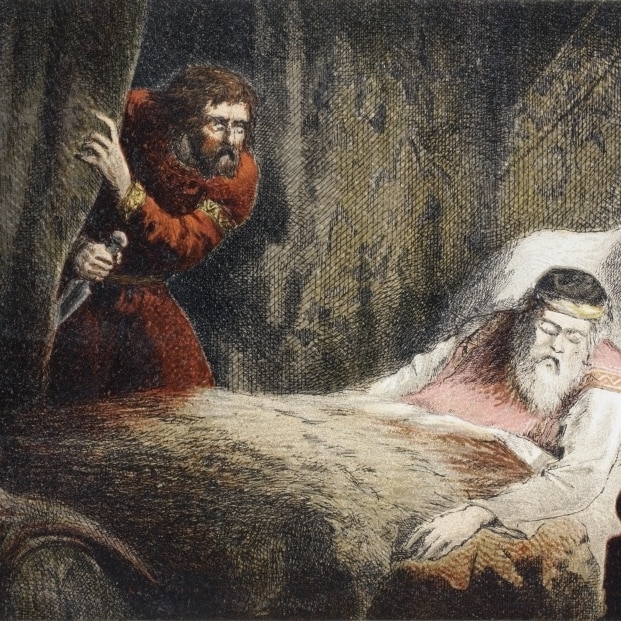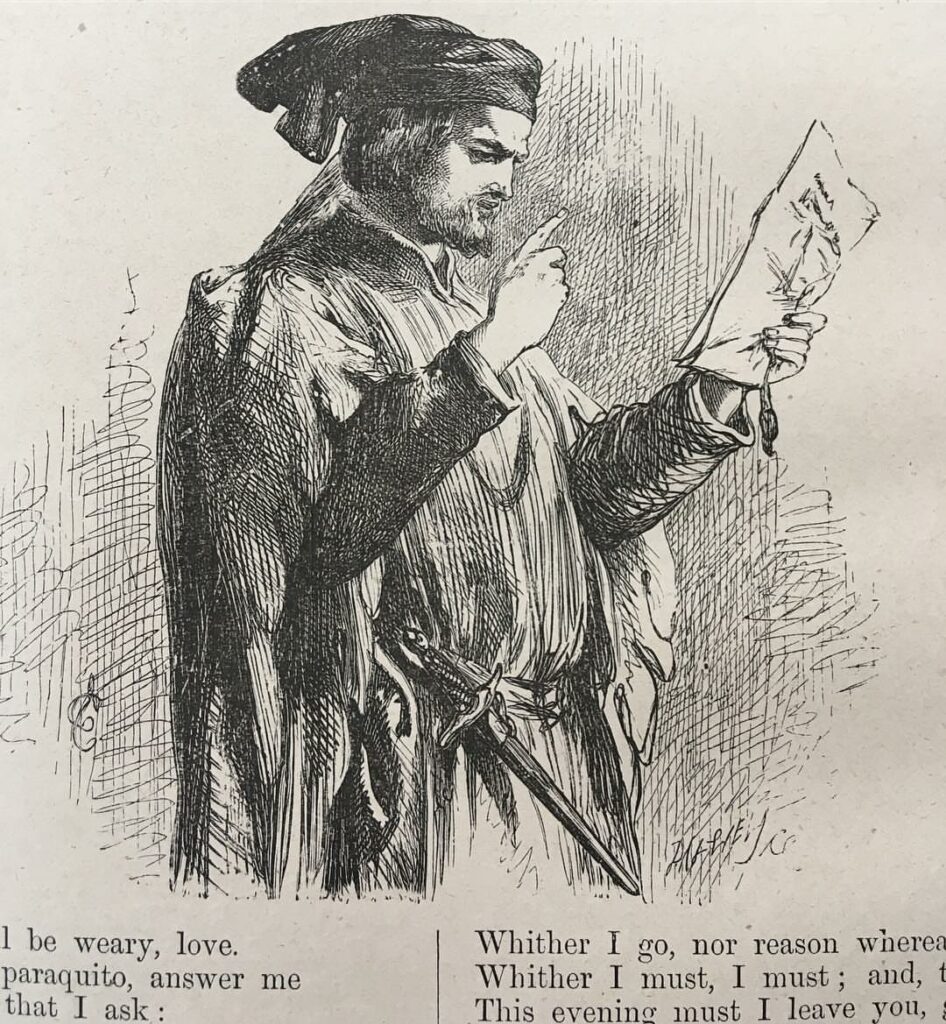Paul Hawkins
Great Books, New Directions: Strategies for Better Student Writing in English
- Introduction

MacBeth about to Murder Duncan – Robert Dudley – The Illustrated Shakespeare (1890) - Freewrites to Kick-start Thinking
- Designing Freewrites and Assignments Around Intriguing Problems
- Revising Essays
- Conclusion
1.Introduction
I came into the WID Writing Fellows program with a 25-year history of working to design meaningful assignments for students, with a particular focus on the traditional genre of the critical essay, and having presented workshops or papers on such topics as the following: the use of student presentations to make big, challenging books teachable; the use of literary criticism (specifically of Northrop Frye and Harold Bloom) in the classroom; live grading—a method I have introduced here at Dawson and that many of my colleagues now use whereby at least some of the students’ major assignments are graded in real time with the student present instead of in the traditional way.
At the same time, while I have long focused courses around the thinking and writing that students will do—teaching competency—I am also a committed teacher of challenging content, and I don’t think that the teaching of competency should make us indifferent to the content: students will develop greater competencies as they are asked and helped to read and respond to great primary texts. And in turn, I need sound pedagogy because I am trying to introduce students to literary classics, works like The Oresteia, Macbeth, Paradise Lost, and Anna Karenina.
My specific goals for WID were to expand my repertoire of informal writing assignments, while specifically reflecting on the hows and whys of informal writing; and as well, to reflect on the use of different genres within the classroom—particularly with the major assignments of the course—so that I wasn’t only using the traditional essay genre. What follows details the major insights that emerged for me from the WID experience.
2. Freewrites to Kick-start Thinking
Most of the smaller “low-stakes” writing assignments that I had been doing were of the “thesis-governed writing” type: I’d ask students to do a formal 1-paragraph response, and then I’d select and discuss successful samples with the class, so that they’d know what to aim for when they’d do a whole essay for me. But the idea of freewriting to encourage students to think of interpretative ideas that they might then develop within an essay made immediate sense to me, and so now constitutes the major short writing assignment that I ask students to do. My hope is that freewrites can actually help accomplish the major thing I’m trying to encourage in students: that they respond authentically to the engaging and intriguing problems that the great works of literature that I teach present (rather than being tempted just to copy-paste something from Sparks notes). Simple as it may sound, encouraging students to avoid the easy route to pretended comprehension is about as major a goal as any I have had. To encourage students just to let ideas flow, without regard to right or wrong, without having to prove that they’re right, without having to revise the freewrite for organization or grammatical correctness—it definitely sounds fun for me, and at least some students really take advantage of it. I also find that freewrites are fun and easy to read and grade. I may only write a small comment (sometimes just a “nice,” or a “good,” or an “interesting” where something prompts thought in me, and I let the students know that this is my encouragement about what they could develop further in an essay if they choose to) – but also, I can start to tell quite quickly who is really thinking and who is not, so that I can offer help to students who need it before major assignments are due.
So that the freewrite is not just “b.s. writing,” one John Bean principle is essential for me: the freewrite is always focused around a reading—for example, the first two acts of Macbeth—and even if not obliged to quote the student should give evidence that they’ve done that reading by referring to some of what happens.
Exhibit A: Winter 2018 Macbeth freewrites and essay topics showing how small freewrites can connect to the larger essay.

3. Designing Freewrites and Major Assignments around Intriguing Problems
The idea of the intriguing problem is something John Bean emphasizes near the beginning of Engaging Ideas and continually revisits: focusing on engaging problems , particularly those that are real within the discipline; having a sharp question that poses the intriguing problem, and giving preference to questions over assignments that are phrased as statements (of the “Discuss x” variety); or giving students a sample thesis, and asking them to defend, refute, or rephrase it. It frees me to give students a really powerfully articulated thesis—it could be a quotation drawn from a critic, but I have tried more often to articulate something that really comes out of the main lines of our discussion of a work—and then encourage them to grab a hold of only a part of it if they choose, and to put their own spin on it. What I have loved about this is that I solve the student’s problem of floundering around in search of a thesis, while at the same time encouraging them to think through one of my suggested theses for themselves.
Exhibit B: Fall 2018 essay topics on Henry IV, Part One, showing how different theses may lead students to engage with large debatable issues, since different theses are in contradiction with the others.
4. Revising Essays
Because I am frequently teaching literary classics, to minimize issues of plagiarism, in my 101, 102, and 103 courses the 3 essays that I ask students to do are all done in class, over two class periods. But so that students can have the opportunity of the at-home essay as well, I allow them to rewrite at least 1 of the first 2 essays (the final grade being the average of the original and revised grade). There’s no need for the student to revise if they’re happy with the original grade, but I can be a harder grader on the original submission because I know they have a chance to improve. Also, now that I am using live grading, and so a revision is also live graded (with the student reading their revised essay to me while I look with them at both versions on the desk), it doesn’t feel like onerous extra work for me at home, but something pleasurable because it’s being driven by the student.
As I was working with revision over the years, I did try to focus revision on making some substantial change and not just correcting errors, but always met with mixed success. Now, suggesting that students add a body paragraph or a further example and discussion to some existing paragraphs has prompted more students to view revision as opportunity for new thinking.
But I also help students improve their writing style: I use Strunk & White’s The Elements of Style as a recommended text. I find our students often say that they don’t know how to use the semi-colon (rule #5), or the colon (#7), or the dash (#8), and sometimes they need a brush-up on at least some of the principles behind the use of the comma (#2-5); rule #5 itself comes up often, because it’s behind the error called the comma splice (though Strunk & White don’t use that term). As well, the “Elementary Principles of Composition” and “An Approach to Style” chapters are timeless in their advice and examples from classic authors.
Exhibit C: Handout on revising essays created while I was WID fellow in fall 2017
5. Conclusion
The Macbeth essay topics also show my limited branching out into alternative genres beyond the critical essay, by giving students the opportunity to write their essay as a letter, with a few fun choices: writing it as a letter to Macbeth or Lady Macbeth, or to Shakespeare, or from one character in the play to another. I’ve enjoyed the alternative-form essays that students produce; and it’s always fun how students often put on a kind of formal, archaic-sounding voice, a semi-imitation of Shakespeare’s style – it gets them to stretch their linguistic muscles, and a part of the beauty of it is that I don’t even mention that part; just asking them to imagine themselves as a character in the story will naturally lead them in new directions.
At the same time as I highlight these explorations in alternative formats, I also want to mention a blog post I wrote for my WID colleagues on how and why it is that I have never felt dissatisfied with the traditional genre of the critical essay. I’d like to quote a part of that post:
“But briefly, allow me to celebrate “the 5-paragraph essay,” and perhaps explain why it is that I have long loved this genre, and continue to believe in it as a core part of what I get students to do, even as I’m expanding the genres used in the classroom. Philip Hobsbaum explains it wonderfully in The Essentials of Literary Criticism, which I have had on my shelf since early in my teaching career. Critical reading is all about having responses to the texts we read, and developing those responses by quoting something from the text that has given you your idea, and then explaining how your idea comes out of that quotation. By doing this, we allow readers to see the process of our thought, and even if they disagree with us, they at least know why we think as we do. A critical essay is simply an enaction of these logical principles. In a memorably concise formulation, he says that in a critical essay every quotation is preceded by a contextualizing comment, and followed by amplifying discussion. My formula to students is as follows: intro paragraph + 3-4 body paragraphs (each body paragraph with a point, minimum 3 quotations + discussion). I tell students that it’s a flexible formula: you can follow each quotation with a comment before introducing the next, but it’s fully possible to put all 3 quotations out there at once, and discuss them all together. Or perhaps 2 of your examples get discussed together, and then the 3rd separately. I even show them good examples from their own writing in which a student gives a lot of the discussion before bringing out quotations. So it should not be a straitjacket. Further, from early in my career (I mean, I think I discovered this pretty much right from the beginning) I’ve allowed students to use “I” in a critical essay (which is historically a no-no in English), and told them that a critical essay is always a combination of the personal and the critical, the subjective and the objective: it’s your interpretation, your thoughts (the subjective part), but it’s the details of the work that you have responded to that have led to your interpretation (the objective part).
I love that Bean himself defends traditional academic writing—including its heuristic value (55)—while also discussing the importance of “expressive” writing (56-58). Using his vocabulary, I think I’ve long had at least some of the “expressive” built into my conception of the critical essay, and when students are playing Macbeth or Lady Macbeth in an essay, we’re moving in the “poetic” (creative) direction as well. But of course, I am only at the beginning of my exploration of alternative genres.”
Indeed, I’m happy to be feeling in mid-career that there are new paths ahead, and that I’m still only at the beginning.
References:
Bean, John C. Engaging Ideas: The Professor’s Guide to Integrating Writing, Critical Thinking, and Active Learning in the Classroom. 2nd edition. San Francisco, CA: Jossey-Bass, 2011.


